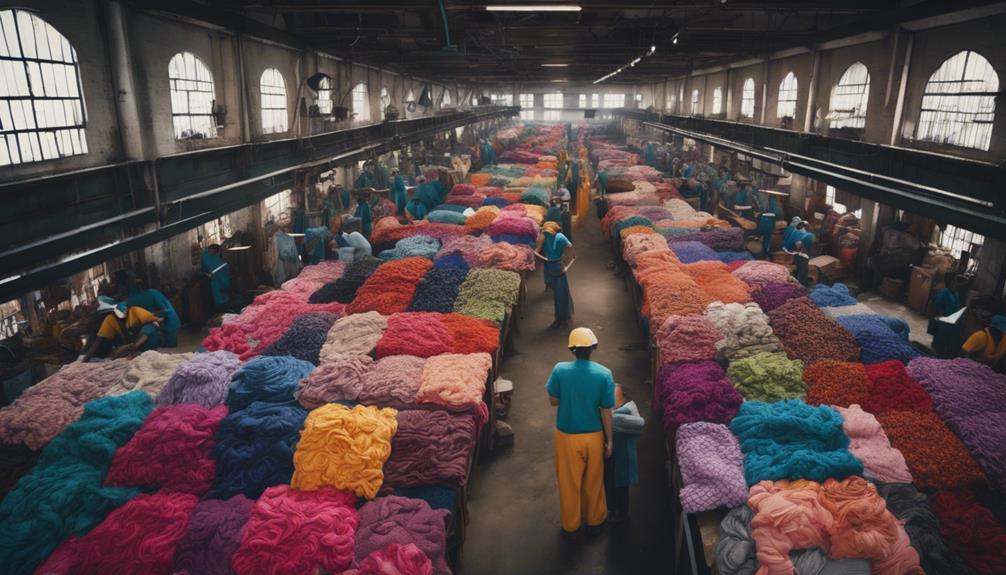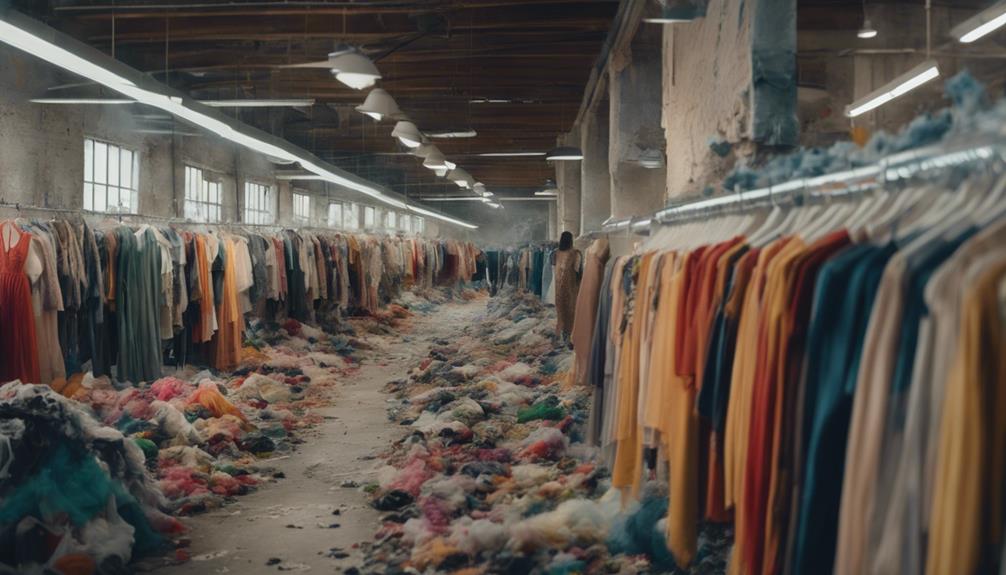Sustainable fashion is typically more expensive than fast fashion, and you may be surprised by the numbers. For instance, organic cotton can cost up to 25% more than standard polyester. Sustainable brands often incur higher costs for ethical labor practices and eco-friendly materials, resulting in a 30% price increase on certified items. Despite the higher upfront cost, sustainable clothing generally lasts longer, providing better long-term value. Many consumers acknowledge this and are willing to pay extra for sustainability. Interested in learning more about the broader impact and benefits of these decisions? There is much more to discover on this subject.
Key Takeaways
- Sustainable fashion items typically cost 25-30% more than conventional materials due to ethical production and quality standards.
- Certified sustainable materials can be up to 30% pricier than standard options, reflecting the investment in eco-friendly practices.
- Labor-intensive production and fair wages for workers contribute to the higher price tag of sustainable garments.
- While initial costs are higher, sustainable fashion offers better long-term value due to durability and quality, reducing cost-per-wear.
Understanding Sustainable Fashion Costs
Understanding the costs of sustainable fashion reveals why these items often come with a higher price tag compared to fast fashion alternatives. Sustainable fashion relies on ethical fashion principles, emphasizing transparency and fairness in production. The use of organic cotton and certified sustainable materials naturally increases production costs. For instance, organic cotton can cost up to 25% more than conventional polyester, while certified materials may be 30% pricier.
These higher prices stem from labor-intensive manufacturing processes and essential certifications like GOTS and OEKO-TEX, ensuring safe working conditions and fair wages. Additionally, the limited supply of certified sustainable materials, coupled with rising consumer demand, further drives up costs in this market.
However, while you might pay more upfront for sustainable clothing, consider the long-term cost-per-wear. These garments are designed for durability and quality, meaning they can withstand the test of time far better than fast fashion items.
Economic Impact of Fast Fashion

Fast fashion's economic impact is staggering, with the industry prioritizing low costs over ethical practices, leading to widespread exploitation and environmental degradation. This business model thrives on overproduction, generating immense textile waste—around 92 million tons annually. You mightn't realize it, but when you purchase cheap clothing, you're contributing to significant environmental issues, including a high carbon footprint and resource depletion.
As consumers, your behavior shapes the market. The allure of fast fashion often blinds you to the hidden costs, such as the estimated $500 billion loss from under-utilized clothing. Fast fashion brands typically allocate around 70% of garment costs to fabric, leaving minimal funds for sustainable practices.
In contrast, sustainable fashion brands focus on eco-friendly clothing, using recycled materials and promoting sustainability initiatives that can help mitigate these impacts. If more consumers choose to support sustainable fashion, the industry could pivot toward ethical practices.
Labor Practices and Pricing

The stark contrast in labor practices between fast fashion and sustainable brands reveals the true cost behind the pricing of clothing. Fast fashion brands focus on minimizing production costs, often allocating a mere fraction of their budgets to wages. This results in garment workers earning as little as 2% of a living wage, highlighting the industry's ethical failings.
In contrast, sustainable brands prioritize fair wages, with companies like Able charging higher prices—$48 for a T-shirt, for instance—because they guarantee their workers are compensated above legal requirements. This commitment to ethical labor practices greatly impacts pricing.
Sustainable brands typically produce in smaller quantities, avoiding overproduction and passing those increased production costs onto consumers. While fast fashion thrives on bulk manufacturing discounts, the true cost of sustainable fashion incorporates not just materials, but also fair compensation and safe working conditions for garment workers.
Quality Materials and Their Prices

Sustainable fashion often relies on higher-quality materials, which greatly impacts the prices you see on the racks. These sustainable materials, like organic cotton, often come with a premium. While organic cotton costs about 25% more than conventional polyester, certified options can be even pricier, by around 30%. Ethical brands focus on fair wages and safe conditions, contributing to higher prices for their garments.
Here's a quick breakdown of some common sustainable materials and their associated costs:
| Material | Price Comparison | Benefits |
|---|---|---|
| Organic Cotton | 25-30% more than polyester | Eco-friendly; soft texture |
| Tencel | 50% more than cotton | Biodegradable; moisture-wicking |
| Hemp | 30% more than cotton | Durable; requires less water |
| Recycled Polyester | Comparable to virgin | Reduces waste; versatile |
| Organic Linen | 40% more than linen | Breathable; long-lasting |
While these durable fibers do have higher production costs and require certifications like GOTS, they often offer better long-term value. Unlike fast-fashion items that quickly wear out, sustainable pieces are designed to last, making them a wise investment.
Consumer Behavior and Perception

Consumers often struggle with the perception that ethical brands are too pricey compared to their fast-fashion counterparts, despite their growing awareness of sustainability issues. You might be surprised to know that many consumers grapple with price barriers that prevent them from investing in sustainable clothing.
Here are some key insights into consumer behavior and perception:
- Awareness vs. Action: 72% of US consumers know about sustainability issues, but only 55% show interest in buying sustainable brands.
- Willingness to Pay: Over 80% of young adults are ready to spend more on sustainable options, yet immediate affordability often leads them to fast fashion.
- Value Misunderstanding: Fast fashion's low costs can skew your perception, making you underestimate the long-term benefits of high-quality sustainable clothing.
- Quality Trade-offs: The high return rates from fast fashion highlight the difference between quick fixes and the durability that sustainable brands offer.
Frequently Asked Questions
How Much More Expensive Is Sustainable Clothing?
Sustainable clothing often costs more than fast fashion due to higher-quality materials and ethical production practices. While you might pay a premium upfront, these items typically last longer, offering better value over time.
What Is the Problem With Sustainable Fashion?
The problem with sustainable fashion lies in its higher costs and limited availability. You might find it harder to access affordable options, but remember, investing in quality can lead to long-term savings and environmental benefits.
What Are the Risks of Sustainable Fashion?
Sustainable fashion carries risks like higher production costs and unsold inventory. You'll face challenges with limited materials and smaller quantities, making it tough to balance prices while maintaining ethical practices without compromising quality or accessibility.
How Much Cheaper Is Fast Fashion Than Sustainable Fashion?
Fast fashion's often much cheaper than sustainable options. You might find T-shirts for $10, while ethical brands charge around $48. The lower prices come from fast fashion's mass production and lower-quality materials.
Can Sustainable Fashion Be Affordable?
Can sustainable fashion be affordable? Yes, with advancements in sustainable fashion production processes, brands can now offer eco-friendly clothing at competitive prices. By using innovative materials and ethical manufacturing, sustainable fashion is becoming more accessible to a wider audience.
Conclusion
When you immerse yourself in sustainable fashion, you'll find it often comes at a higher price than fast fashion.
However, consider this: a 2021 report revealed that the average cost of a sustainable garment is about 30% more than its fast-fashion counterpart.
This difference reflects ethical labor practices and quality materials.
While it may seem shocking at first, investing in sustainable fashion means supporting a more responsible industry that values both people and the planet.









